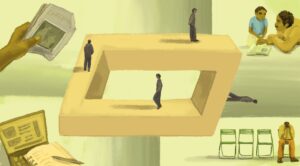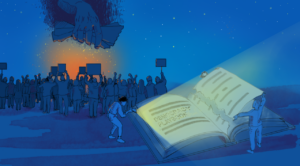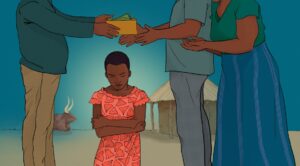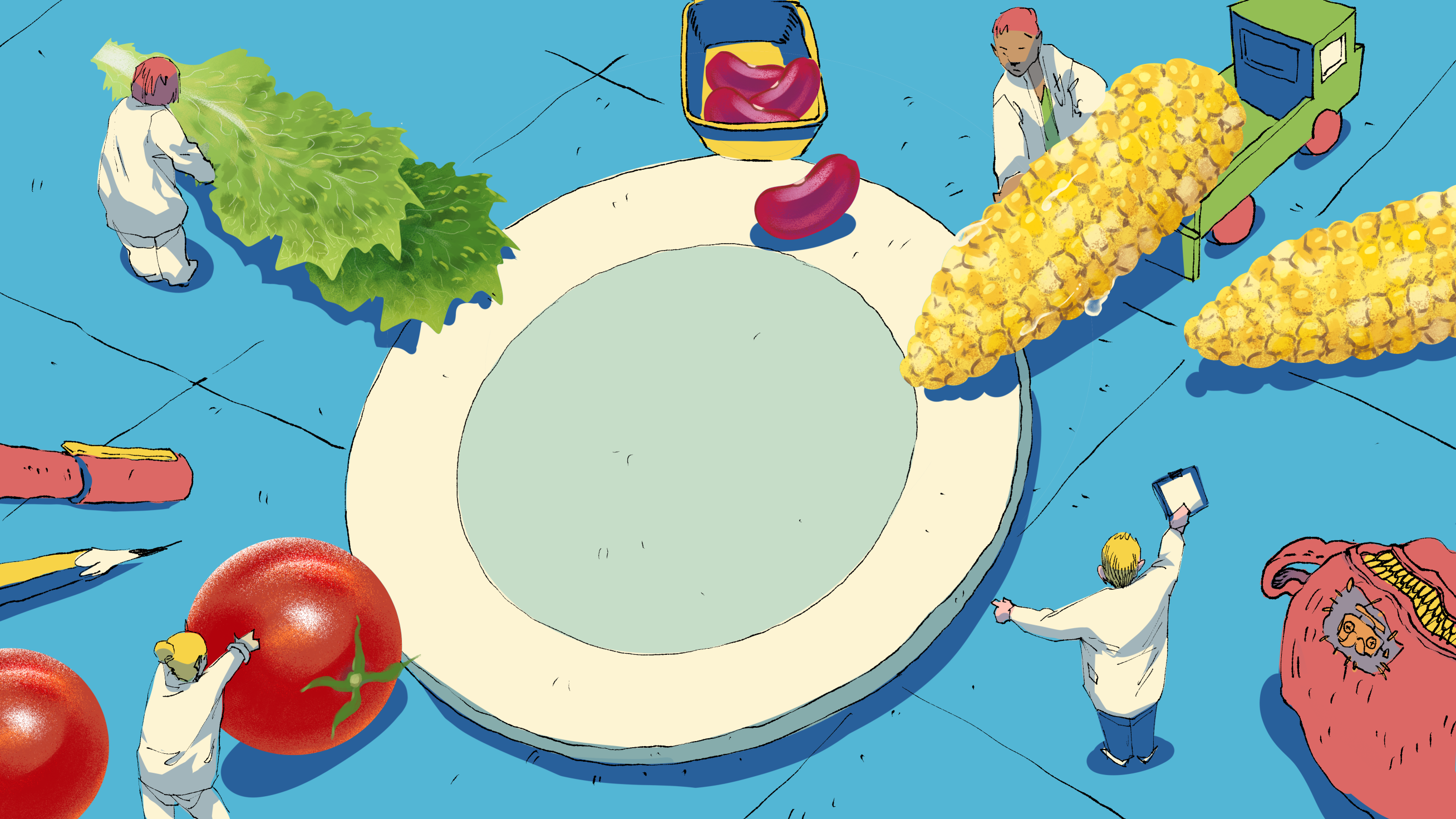
This man wants to revolutionize what’s on the menu for school children
- Written by Julia Tappeiner
- Illustration by Frauke Berger
Serving seasonal, organic and increasingly plant-based food in schools not only helps children, but also the climate. A unique window of opportunity has just opened up in the EU.
Anna has just finished up five hours of lessons. That’s a lot for the brain of a 10-year-old. That makes it all the more important for her to recharge her batteries. And what better way to do that than with a healthy meal? She runs to the school cafeteria with her class in anticipation. On the menu today: spaghetti bolognese.
But the noodles are made of highly processed flour and thus contains hardly any nutrients. The ground meat? Of unknown origin. It’s also unclear how the tomatoes were produced or where they come from. This diet plan is not particularly healthy – neither for Anna’s body nor for planet she lives on and its climate.
What do healthy school meals have to do with climate change? Peter Defranceschi has been asked this question many times in his life, especially by politicians.
He is the director of Local Governments for Sustainability (ICLEI) in Brussels, an association of 2,500 cities and regions around the world that want to reduce their carbon footprint. For years, he has been trying to get the issue of climate-friendly agriculture and food onto the political agenda of climate conferences and meetings of the EU institutions; but for a long time, this has been a Sisyphean task. Politicians and entrepreneurs prefer to talk about less sensitive issues, such as renewable energy or reforestation of the rainforests. After all, the questions of what we want to eat in the future and how we can produce food in a climate-friendly way affects our own lives and personal preferences much more directly. Even environmental organizations often shy away from using words like “meat avoidance.”[1]
According to a study in the journal Nature Food, our food system is responsible for one third of global greenhouse gases, especially our agriculture and land use.[2] The latest report of the environmental organization World Wildlife Federation (WWF), “Europe eats the world” shows: The EU is the world’s second-largest importer of products related to rainforest deforestation. What we eat not only heats up the planet but also destroys habitats and reduces the diversity of animal and plant species.[3]
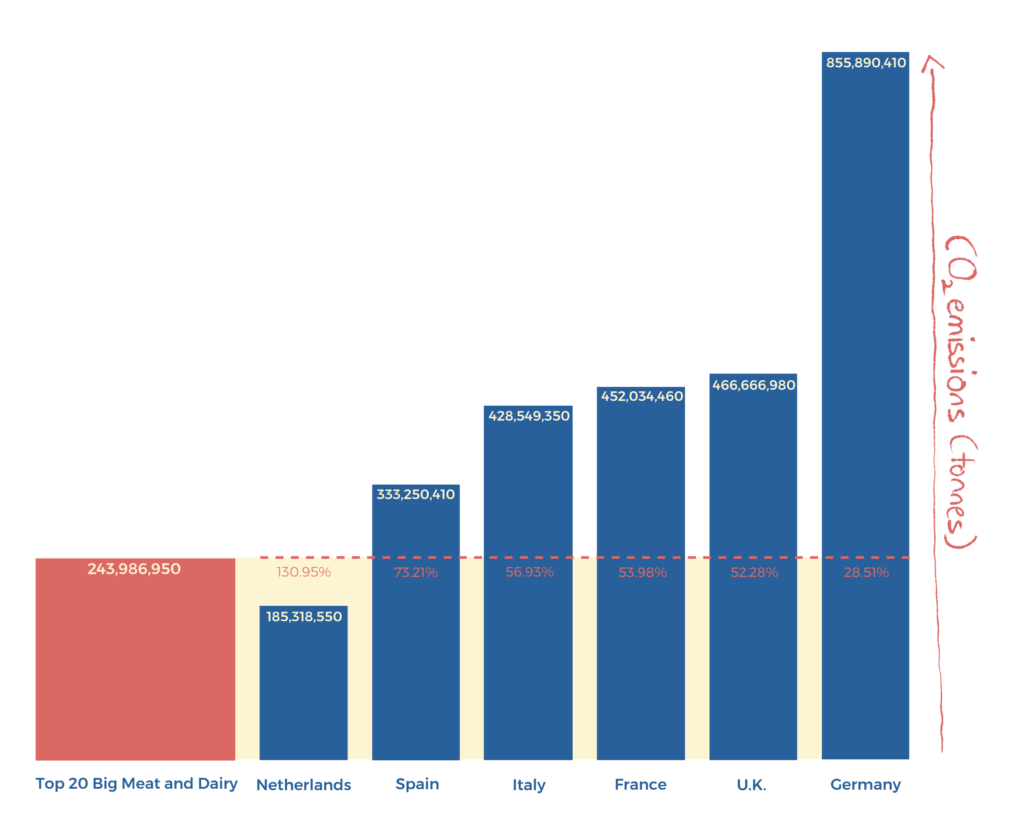
At the same time, the report also shows that consumers are ready for change. Three out of five Europeans want to eat in a more climate-friendly way; three out of four even want the EU to legislate that all products sold in the EU do not contribute to species extinction.
The EU Commission now seems to have understood this. It wants to make our plates greener and has launched the “Farm-to-Fork Strategy” to this end. By the end of 2023, the Commission plans to present a concrete legislative package for a more sustainable food system in the EU.
This is Peter Defranceschi’s moment. With the “buy better food” campaign, his network ICLEI has developed a proposal for how this strategy can be implemented at public cafeterias, such as school or hospital dining halls.
Small plate, big effect
Peter Defranceschi’s goal is to ensure that what ends up on our children’s plates should be healthy, fairly produced and environmentally friendly.
“The EU does advise municipalities, as public procurers, not to look solely at the low price when tendering for food supplies. However, this is often a voluntary measure,” Defranceschi says. In reality, municipalities often hire individual catering companies to supply several hundred kindergartens in order to save costs. This makes it much more difficult to enforce or monitor environmental standards.
That’s why ICLEI, together with other EU non-governmental organizations, has drafted a manifesto with seven goals for sustainable catering in schools or health care facilities and handed it over to the Commission in October:
According to their plan:
-20% of the food should come from organic farming
-10% of the food should be produced by small producers in the region
-25% of greenhouse gases to be reduced, by adding more plant-based food to the menu, by shortening supply chains and serving seasonal vegetables and fruits, and by throwing away less food.
-25% of food imported from outside the EU – coffee, bananas, tea – should be “fair trade products.”
-The selected supplier companies should prove that the working conditions for their employees are 100% fair, i.e., comply with applicable collective agreements, EU standards as well as national law
-Public meals should be guided by a healthy eating plan. While some countries already have such guidelines, they should be developed more concretely at the EU level and compliance with them should be better monitored. As guidelines, the authors of the manifesto suggest, for example, serving 75% of cereal dishes as whole grains or giving preference to suppliers who offer drinks with less sugar.
-Suppliers who guarantee a higher level of animal welfare should be awarded prizes.
Defranceschi, himself the father of two schoolchildren, is particularly concerned about the supply of food in schools. That is why ICLEI has also launched a petition: “A healthy meal for every child at every school“, which also calls for children to be taught healthy eating and proper cooking in class.
The approach sounds like a smart solution for a modern food system. But how realistic is it in practice? To understand this, it helps to look at countries that are already implementing such programs.
What schoolchildren in other countries eat, and what the EU can learn from them
Several European countries have already been implementing some of the goals in the manifesto for years. Defranceschi is convinced that if the entire EU shapes its delivery criteria for meals at schools or in the healthcare sector accordingly, this will not only protect the planet, but also public health, and will make the food system more socially just.
The fact that lesser meat and dairy products, as well as shorter supply chains, save CO2, has already been studied many times. The Vienna Health Association shows what this can look like in practice. It supplies meals to eight hospitals, nine care centers and one therapy center in Vienna. In 2010, it introduced climate-friendly minimum criteria for its meal deliveries with the “Natürlich gut Teller” (“Naturally good plates”) project. Since then, the meals contain only seasonal and regional fruit and vegetables, at least 30% of the food comes from organic farming, the proportion of meat has been greatly reduced and fish comes only from organic fisheries in Austria. The result, according to research by the non-governmental organization Healthcare without Harm, by choosing seasonal and regional food, the city reduced its CO2 emissions by 21,600 tons per year. This corresponds to the annual CO2 footprint of around 2,000 people. And it even came at a lower cost: Because less meat was served, the city saved 57,000 euros. [4]
Italy is also a pioneer when it comes to sustainable school meals: for example, the nationwide criteria stipulate that between 50% and 100% of meals served in schools must be organic (the percentage varies depending on the type of food). Suppliers of regional and seasonal products are also awarded prizes in tenders. The city of Rome is even tackling the consumption of animal foods: Roman kindergardens and schools serve meat no more than two times a week. According to an analysis by the EU Commission, the city can save almost 9,000 tons of CO2 a year thanks to the reduction in meat.
Local effects and poverty reduction
Since 2013, the Belgian city of Ghent has been working on a climate-friendly food policy that fights poverty and supports local, small-scale farmers. The city council introduced a digital platform that connects food buyers (restaurants, delivery services) with local producers, thereby providing incentives for shorter supply chains.
Since then, the city has been recognized throughout the EU as a pioneer in local circular economy and sustainable food production.
In addition, Ghent launched a platform to distribute food to those in need that would otherwise be thrown away. 1,000 tons of surplus food has been distributed to over 57,000 people in need over the last 2 years.
Zeroing in on children's health
Children in the EU are eating an increasingly unhealthy diet. One in three children are now overweight, says the World Health Organization. “It’s time for school meals to become healthier and more nutritious,” says Defranceschi. That includes less sugar, less salt, and fewer processed foods. Considering that for many children, school meals make up more than half of their daily diet, it becomes clear how important school meals in particular are for children’s health.
Defranceschi adds, “You’d have to combine that with cooking classes and nutrition education so kids learn how to cook healthy meals for themselves down the road.”
At the moment, only two EU countries have cooking courses in their curricula: Sweden and Finland. Research on the impact of such programs is still in its early stages. A 2014 study of Finnish schools had mixed results: Cooking classes and nutrition education could indeed positively influence children’s eating behavior. However, it is not possible to say exactly what type of program is ideal and what role the influence of parents plays. Further studies are therefore needed.
This is precisely what ICLEI wants to do. They launched the “Schoolfood4change” (in German: Schulmahlzeiten für den Wandel) program in January of this year. [5] For four years, 3,000 schools in 16 partner cities and 12 EU countries will introduce sustainable criteria for meal tenders and integrate nutrition programs into their lessons. Researchers are accompanying the project and studying its impact on children’s health.
Where the edge of the plate ends
Moreover, unclear definitions carry the risk of greenwashing, Defranceschi explains. For example, how is "healthy food" defined? At what point is a farm considered a "small producer"?
Potential solutions: Independent dieticians could help determine the criteria for healthy food, as in Italy. And for “small producers” ICLEI proposes the following definition: “These are farms that do not make more than 100,000 euros in sales per year and employ a maximum of five employees (in addition to their own family). The maximum area depends on the product and the country’s own regulations.”
One argument that is often used against climate-friendly, regional food programs is that the price is too high. This is only partially true. The city of Vienna, for example, has spent less money through the “Natürlich gut Teller” project described above, in which meat was reduced. Defranceschi adds, “Also, any higher price is offset by the fact that we eat healthier and therefore can make savings in the health care system.”
Defranceschi sees the biggest hurdle in political will:
"In theory, everyone always thinks our idea is great. But when it comes to introducing it, it's often difficult. Especially in regions where the conventional agricultural sector is very strong, because votes are at stake. I would sometimes like to see politicians showing more courage in aligning policies with the EU's sustainability goals and thinking about future generations."
European decision-makers could find motivation in the global South. There, some countries – Ethiopia, Kenya or the Philippines, for example – have progressive food programs. Defranceschi was inspired by such regions and, together with the United Nations Environment Programme, has recorded the best-practice examples in the podcast “The Power of the Public Plate.”
You can read more about these programs in upcoming articles in our Chain Reactions series.

This project was funded by the European Journalism Centre, through the Solutions Journalism Accelerator. This fund is supported by the Bill & Melinda Gates Foundation.
Notes:
[1] The documentary “Cowspiracy” got to the bottom of this phenomenon. On Utopia you can find a summary.
[2] They account for 70% of these greenhouse gases. The remaining 30% are related to the product’s supply chain, for example packaging, industrial processes or transport.
[3] On the day of species protection, the Perspective Daily editorial team wrote a text on why we need biodiversity.
[4] Assuming that an average European emits about 11 tons of CO2 per year.
[5] This is funded by the EU with 12 million euros.
Please consider a donation to support the work of our all-women newsroom. We create a space for journalists facing structural barriers, working towards a more equitable, inclusive world of journalism. Join our mission today!

